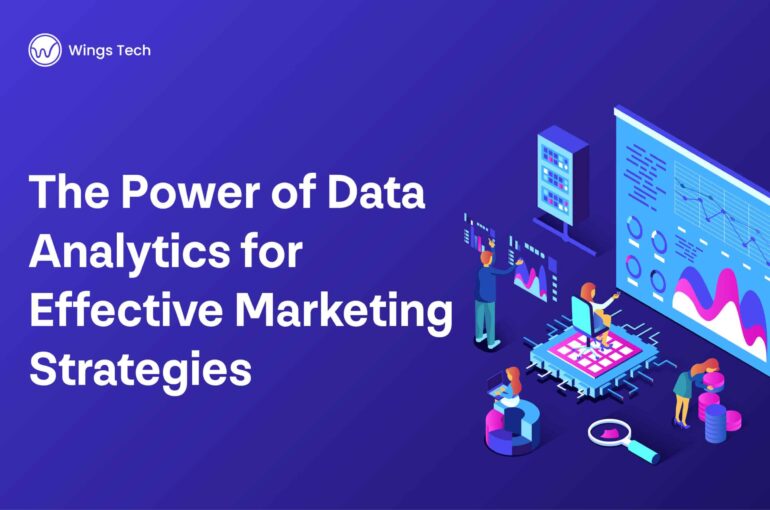The Power of Data Analytics for Effective Marketing Strategies

Have you ever thought about how effectively companies and their businesses attract us in the strangest ways? It’s as if the companies can read our minds and have telepathic abilities. They know exactly what we like and can sell their products to us when we need them. Sometimes they can sell them even when we don’t need them. How do they do this? What sorcery is this?
Well, to reveal this secret, we need to understand the correlation between businesses and technology. As long as technology keeps on advancing, it is evident that the way businesses are conducted will keep on changing dynamically.
The most prominent technological advancements that are currently taking place are in the field of data science. Be it AI, Business Intelligence, Data Engineering, or Data Analytics, all the facets of this field are expanding at an unprecedented rate. But you must be thinking, what is the connection between these and the magical selling spree that the companies are on? It turns out that successful companies take advantage of data analytics to conduct their business. They use it primarily to power their marketing strategies.
Now that you’ve got a rough idea about how companies become customer magnets, let’s dive deep into the reason behind it, i.e. the usage of data analytics.
What is Data Analytics?
Data Analytics is the science of analyzing a huge amount of raw data and then coming to a conclusion based on that. The information that is derived after concluding a certain aspect is then used to take strategic decisions to pivot the direction of companies’ efforts to run the business.
It is used to curate any kind of strategy in a business. In this excerpt, we are talking about marketing strategies.
When data analytics is used specifically for marketing, it can be called marketing analytics. Simply said, marketing analytics is used to target a specific audience rather than keeping a large demographic in consideration. This is mostly based on gathering data on the psychology and behavioral patterns of potential consumers.
It can help companies make business decisions on what kind of ads they would want to create and to what kind of audience they wish to show them. It also helps them decide the kind of branding they’d want to create for their company or product based on the kind of connection they might have with their consumers.
Walking in Customers’ Shoes
The data generated from potential customers’ clicks and taps on the websites and the apps of a business are largely based on their habits. Factors like their browsing behavior, visits to their favorite brands’ websites, their previous purchase history, or even just the items they have added to their cart waiting to be shipped can affect the marketing strategy the companies might want to execute. So, they put themselves into the shoes of their customers and curate strategies based on their behavior.
Based on the marketing plan, the decisions are altered. If retargeting ads is their marketing strategy, then they need to create personalized messages for their audience, based on the number of times the ad was seen or clicked on.
Helps Creating Buyer Personas
With effective data analytics one can generate an accurate buyer persona. A detailed semi-fictional representation of an ideal potential customer can be called a buyer persona. This can especially be effective in the initial phases of your marketing efforts when you don’t know if your customer will like your product or service. Talking about data analytics here, it can be said that it is a constant process, be it before selling a product, during a sale, or after the sale is executed.
Helps Gathering Business Intelligence
Business Intelligence is also pretty much derived from walking in consumers’ shoes. Data gathered after listening to and knowing the customer’s demands, likes, dislikes, etc. can be used to come up with various ways to satisfy the customer better. You can consider business intelligence as the main input for data analytics.
For example, if you run a restaurant, your business intelligence can be generated in both ways, online and offline. When the customer is done with their food, you will know they liked the food if they tip you. Similarly, if your restaurant is also listed on an online portal, your customers will write good or bad reviews about the food, ambiance, and hospitality of your restaurant. This will help you take better decisions in the future. Simply put, business intelligence for marketing is just a glorified phrase for customer feedback.
Bonus: A Few of the Best Data Analytics Tools for Marketing
Google Analytics
Google Analytics is a web analytics tool used to track your CTR (click-through rate), website traffic, advertising ROI (Return On Investment), and social media sites and applications.
Improvado
Improvado is an enterprise-level marketing analytics web application that automates your sales, marketing, and ROI data collection and makes your data analysis process easier with its in-built marketing analytics pipeline.
TubeBuddy
TubeBuddy is a browser extension for YouTube creators that provides insightful analysis of the performance of your video. It has features like keyword and tags optimization, SEO studio, the ability
to A/B test your video before publishing, etc.
TapClicks
TapClicks is an analytics tool that provides a cloud-based platform for marketing, reporting, and analytics.
Salesforce Marketing Cloud
Salesforce Marketing provides cloud-based integration of all your big data into one single platform so that you can have a complete picture of your data making your analytics journey easier.
Hope you found this blog insightful! Stay tuned for more such blogs on wingstechsolutions.com.


















